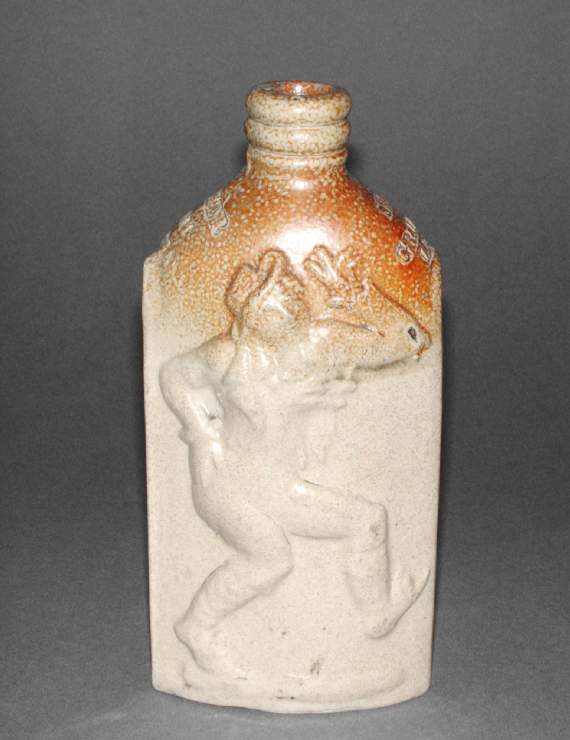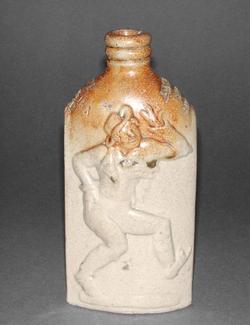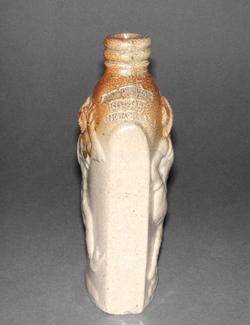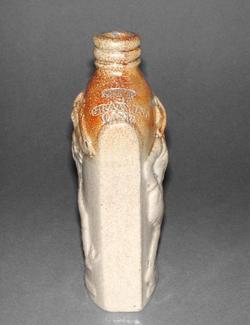Current Location: In storage
Maker(s)
Production:
Lambeth Pottery
(Possibly)
Entities
Categories
Legal notes
Dr J. W. L. Glaisher Bequest
Measurements and weight
Height: 17.7 cm
Acquisition and important dates
Method of acquisition: Bequeathed
(1928-12-07)
by
Glaisher, J. W. L., Dr
Dating
1830s
William IV
Production date:
circa
AD 1836
Note
This flask depicts the white American actor Thomas Dartmouth Rice (1808-60) in his most famous role, that of ‘Jim Crow’, supposedly an elderly black man. Rice performed blackface and drew on aspects of African American culture, most notably vernacular speech, music and dance. His ‘Jim Crow’ persona was appropriated from the folk stories of a trickster by the same name that had long been popular among enslaved black people. Rice also popularised a traditional slave song entitled ‘Jump Jim Crow’ (1828). However, his exaggerated and racist depiction of the character meant that the term ‘Jim Crow’ was later used to refer to a generalised negative and stereotypical view of black people and was applied to the segregation laws that became prevalent in the U.S.A between 1870s and 1960s.
The source of the moulding of the figure on this flask is an image of Rice’s character that appears on the lithograph music cover of a song performed by Rice when he visited England. Rice’s performances had long been popular in North America but he also became well-known in England after performing at the Surrey Theatre, Southwark, London, in 1836, before moving to the more upmarket Adelphi Theatre to perform in a play based around his ‘Jim Crow’ character.
A number of flasks depicting Rice in character were made at that time, most probably in Lambeth. Similar examples without the impressed inscription can be found in the Southwark Art Collection (no. CE127) and in the collection of the Victoria and Albert Museum (no. C.40-2002), who also record a similar flask with a single hook attached to the shoulder, marked by the modeller and potter, Thomas Wetherill of Lambeth. An example with a handle, in the collection of J. F. Mott, is illustrated in J. F. Blacker (1922) 'The A B C of English Salt-Glaze Stone-Ware', London: Stanley Paul & Co., plate opposite p. 116, which is described, perhaps erroneously, as made at Fulham.
This is the only known example with an impressed inscription (see below). It may refer to Joseph Archer of the Ship Public House, 32 ½ Gray’s Inn Lane, recorded in the Post Office London Directory of 1843.
People, subjects and objects depicted
Components of the work
Upper Part
composed of
brown dip
( on upper part)
Surface
composed of
salt-glaze
Materials used in production
buff
Stoneware
Techniques used in production
Press-moulding
: Buff stoneware, press-moulded, dipped brown on the upper part, and salt-glazed
Inscription or legends present
- Text: SHIP / GRAY'S INN / LANE\
- Location: On left shoulder
- Method of creation: Impressed
- Type: Inscription
- Text: ARCHER / SPIRIT / MERCHANT
- Location: On right shoulder
- Method of creation: Impressed
- Type: Inscription
References and bibliographic entries
Identification numbers
Accession number: C.1220-1928
Primary reference Number: 71613
Old object number: 3344
Stable URI
Audit data
Created: Saturday 6 August 2011
Updated: Monday 25 March 2024
Last processed: Tuesday 22 July 2025
Associated departments & institutions
Owner or interested party:
The Fitzwilliam Museum
Associated department:
Applied Arts







